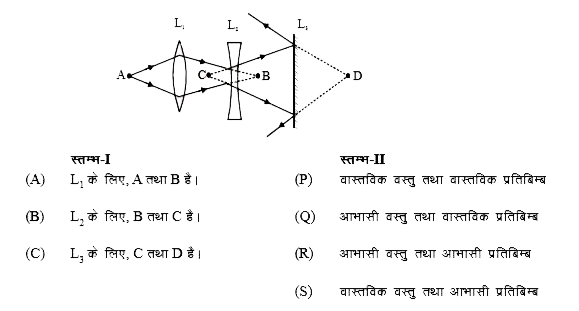L1,L2L3 प्रकाशीय तंत्र है तो स्तंभ-I का स्तम्भ-II मिलान करो |

The correct Answer is:(A)P(B)R(C)S
Step by step video & image solution for L_(1), L_(2) L_(3) प्रकाशीय तंत्र है तो स्तंभ-I का स्तम्भ-II मिलान करो | by Physics experts to help you in doubts & scoring excellent marks in Class 12 exams.
Updated on:21/07/2023Topper's Solved these Questions
- ज्यामितीय प्रकाशिकी BOOK - BANSAL HINDICHAPTER - ज्यामितीय प्रकाशिकी EXERCISE - EXERCISE-2 (Subjective Questions)
36 Videos
- ज्यामितीय प्रकाशिकी BOOK - BANSAL HINDICHAPTER - ज्यामितीय प्रकाशिकी EXERCISE - EXERCISE-3 (JEE Main Previous Year)
15 Videos
- ज्यामितीय प्रकाशिकी BOOK - BANSAL HINDICHAPTER - ज्यामितीय प्रकाशिकी EXERCISE - EXERCISE-1 [REASONING TYPE]
6 Videos
- आधुनिक भौतिकी BOOK - BANSAL HINDICHAPTER - आधुनिक भौतिकी EXERCISE - EXERCISE - 5 (CBSE Previous Year.s Questions)
45 Videos
- विद्युत चुम्बकीय तरंग BOOK - BANSAL HINDICHAPTER - विद्युत चुम्बकीय तरंग EXERCISE - EXERCISE-5 ( SECTION-A) (CBSE PREVIOUS YEAR.S QUESTIONS)
54 Videos
Similar Questions
दो समतल दर्पणों के परावर्तित पृष्ठ एक दूसरे के सामने रखे है, एक दर्पण का एक किनारा दुसरे दर्पण के किनारे के साथ सम्पर्क में है ताकि दर्पणों के मध्य कोण 60∘ है। X-अक्ष के सापेक्ष प्रतिबिम्ब की सभी कोणीय स्थितियां ज्ञात कीजिये। स्थिति लिजिये जब एक बिन्दु वस्तु दर्पणों के मध्य 1. 1) पर है। कटान बिन्दु (0.0) तथा प्रथम दर्पण x-अक्ष के अनुदिश है।
View Solutionलाल प्रकाश के लिए काँच का अपवर्तनांक 1.520 तथा नीले प्रकाश के लिए काँच का अपवर्तनांक 1.525 है। मानाकि इस काँच के प्रिज्म में लाल तथा नीले प्रकाश के लिए न्यूनतम विचलन कोण D1 व D2 है, तो
View Solutionकथन-1 : यदि एक खुरदरी दीवार पर प्रकाश श्रोत से प्रकाश आपतित किया जाता है। तो प्रतिबिम्ब नहीं दिखाई देता।
कारण 1: दीवार प्रकाश को परावर्तित नहीं करती।
View Solutionविभवान्तर V से त्वरित एक इलेक्ट्रॉन से सम्बन्धित डी-बाग्ली तरंगदैर्ध्य λ है। यदि त्वरक विभव को बढ़ाकर 4V कर दिया जाये तो इसकी तरंगदैर्ध्य क्या होगी?
View Solutionकला सम्बद्ध प्रकाश स्रोत क्या है? दो प्रकाश स्रोतों के कला सम्बद्ध होने की दो शर्त लिखिये। यंग के द्विस्लिट प्रयोग में प्राप्त व्यतिकरण फिन्जों की चौड़ाई के लिये एक उपर्युक्त चित्र की सहायता से गणितीय व्यंजक व्युत्पन्न कीजिये।
View SolutionYou are given three lenses L_(1),L_(2) and L_(3) each of focal length 20 cm. An object is kept at 40 cm in front of L_(1), as shown. The final real image is formed at the focus 'I' of L_(3). Find the separations between L_(1),L_(2) and L_(3).
View SolutionGiven : li=44.2±=0.1 and l2=23.1±0.1 the uncertainty in l1+l2 is
View SolutionLet L be the set of all straight lines in plane. l1 and l2 are two lines in the set. R1,R2 and R3 are defined relations.
(i) l1R1l2:l1 is parallel to l2
(ii) l1R2l2:l1 is perpendicular to l2
(iii) l1R3l2:l1 intersects l2
Then which of the following is true ?
View SolutionIf l1,l2 and l3 are the orders of the currents through our nerves, domestic appliances and average lightening, then the correct order of currents is
(1) l1>l2>l3 (2) l1>l3>l2
(3) l1<l2<l3 (4) l1=l2=l3
View Solutionयदि L1,L2,L3.... स्वप्रेरकत्व की कुण्डलियाँ श्रेणीक्रम में जुडी है तो परिणामी स्वप्रेरकत्व
L=L1+L2+L3+...
View Solutionयदि L1,L2,L3.... स्वप्रेरकत्व की कुण्डलियाँ समान्तर क्रम में जुडी है तथा परिणामी स्वप्रेरकत्व L है तो
1L=1L1+1L2+1L3+.....
View Solutionरेखायें l1 व l2 प्रतिच्छेदी है तो उनके बीच की न्यूनतम दूरी होगी -
View SolutionConsider the lines given by
L1:x+3y−5=0, L2:3x−ky−1=0 L3:5x+2y−12=0
Column-IColumn-II(A),L1,L2,L3 are concurrent, if(p)k=−9(B) One of L1,L2,L3 is parallel to at least one of the other two, if(q)k=−65(C)L1,L2,L3 from a triangle, if(r)k=56(D)L1,L2,L3 do not from a triangle, if(s)k=5
View SolutionYour are given three lenses L1,L2 and L3 each of focal length 20cm. An object is kept at 40cm in front of L1 as shown. The final real image is formed at the focus I of L3. Find the separation between L1 and L2 and L3.

View SolutionYou are given three lenses L1,L2andL3 each of focal length 20 cm. An object is kept at 40 cm in front of L1, as shown. The final real image is formed at the focus 'I' of L3. Find the separations between L1,L2andL3.

View Solution
